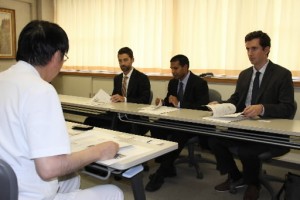U.S. doctors learn about effects of A-bomb radiation in HICARE training program
Jul. 24, 2015
by Hidetoshi Arioka, Staff Writer
On July 14, three doctors from the U.S. state of California visited the Hiroshima Red Cross Hospital & Atomic-bomb Survivors’ Hospital in Naka Ward and Hiroshima University’s former Research Institute for Nuclear Medicine and Biology (now the Research Institute for Radiation Biology and Medicine) in Minami Ward to learn about the effects of radiation emitted from the atomic bomb. Their visit is part of a training program provided by the Hiroshima International Council for Health Care of the Radiation-exposed (HICARE), a local organization established by Hiroshima Prefecture, the City of Hiroshima, and other institutions.
Shunichi Kaseda, the deputy director of the hospital, delivered a presentation on the damage caused by the atomic bomb and the relief activities pursued by the survivors. He explained that, depending on the duration after the atomic bombing, A-bomb radiation sickness and related diseases are divided into acute effects, aftereffects, and late effects. The three visiting doctors asked questions about support for A-bomb survivors abroad and the diseases that survivors are at high risk of developing.
Kingshuk Das, 39, an assistant professor and associate medical director in the Department of Molecular Pathology at the David Geffen School of Medicine at UCLA, said they would like to learn about the experiences and knowledge acquired by medical personnel and researchers in Hiroshima out of concerns connected to the proximity of a nuclear power plant in Los Angeles and the frequency of earthquakes there.
The HICARE training program is scheduled to run from July 13 to 17. The doctors will listen to city officials explain support measures for A-bomb survivors and also visit the Hiroshima Atomic Bomb Casualty Council in Naka Ward and the Radiation Effects Research Foundation in Minami Ward.
(Originally published on July 15, 2015)
On July 14, three doctors from the U.S. state of California visited the Hiroshima Red Cross Hospital & Atomic-bomb Survivors’ Hospital in Naka Ward and Hiroshima University’s former Research Institute for Nuclear Medicine and Biology (now the Research Institute for Radiation Biology and Medicine) in Minami Ward to learn about the effects of radiation emitted from the atomic bomb. Their visit is part of a training program provided by the Hiroshima International Council for Health Care of the Radiation-exposed (HICARE), a local organization established by Hiroshima Prefecture, the City of Hiroshima, and other institutions.
Shunichi Kaseda, the deputy director of the hospital, delivered a presentation on the damage caused by the atomic bomb and the relief activities pursued by the survivors. He explained that, depending on the duration after the atomic bombing, A-bomb radiation sickness and related diseases are divided into acute effects, aftereffects, and late effects. The three visiting doctors asked questions about support for A-bomb survivors abroad and the diseases that survivors are at high risk of developing.
Kingshuk Das, 39, an assistant professor and associate medical director in the Department of Molecular Pathology at the David Geffen School of Medicine at UCLA, said they would like to learn about the experiences and knowledge acquired by medical personnel and researchers in Hiroshima out of concerns connected to the proximity of a nuclear power plant in Los Angeles and the frequency of earthquakes there.
The HICARE training program is scheduled to run from July 13 to 17. The doctors will listen to city officials explain support measures for A-bomb survivors and also visit the Hiroshima Atomic Bomb Casualty Council in Naka Ward and the Radiation Effects Research Foundation in Minami Ward.
(Originally published on July 15, 2015)








